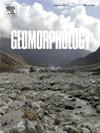Restoring volcanic ocean island palaeotopography to uncover island-scale buried sector collapses
IF 3.1
2区 地球科学
Q2 GEOGRAPHY, PHYSICAL
引用次数: 0
Abstract
A volcanic edifice much larger than the current one must have existed in Santiago Island, Cape Verde, because the granular rocks and dyke-in-dyke complex representing magma chambers and deep feeders currently outcrop up to 700 m altitude. Therefore, we aim to find an explanation for the massive destruction of the original edifice. We developed a new tool for the quantitative reconstruction of ancient topographies in a volcanic ocean island to address this problem, because it allows us to estimate the shape and volume of volcanic rock removed at a certain time. The reconstruction of the topography of the basement complex at ca. 6 Ma ago, before the unconformable deposition of a submarine complex, shows a large eastward concave depression coincident with the asymmetric distribution of volcanic complexes east and west of the eastward concave main divide of the island. This concave depression is here interpreted as the scar of an island-scale, east-directed, sector collapse. Given the position of Santiago relative to the nearby Maio Island, which could work as a buttress in the east, we conclude that the debris generated by the inferred eastward collapse might have been diverted to the northeast. A west-directed sector collapse can be recognised from the topography of the island and marine geophysical data, which supports, by similarity, the sector collapse inferred for eastern Santiago. This methodology could be replicated in many other oceanic islands worldwide where granular rocks currently outcrop above sea level.
恢复火山海洋岛古地形,揭示岛级埋藏板块崩塌
佛得角圣地亚哥岛一定存在过比现在大得多的火山大厦,因为颗粒状岩石和脉间复合体代表了岩浆房和深层补给器,目前在海拔700米的地方露头。因此,我们的目标是为原建筑的大规模破坏找到一个解释。为了解决这个问题,我们开发了一种新的工具,用于定量重建火山海洋岛屿的古代地形,因为它可以让我们估计在特定时间移除的火山岩的形状和体积。在海底杂岩不整合沉积前约6 Ma,基底杂岩的地形重建显示出一个巨大的东凹坳陷,与该岛东凹主裂的东西两侧火山杂岩的不对称分布相吻合。这个凹凹的洼地在这里被解释为一个岛屿规模的、向东的板块崩塌留下的疤痕。考虑到圣地亚哥相对于附近的马约岛的位置,它可能在东部起到支撑作用,我们得出结论,由推断的向东崩塌产生的碎片可能被转移到东北方向。从该岛的地形和海洋地球物理数据可以识别出向西的扇区崩塌,通过相似性,这支持了圣地亚哥东部推断的扇区崩塌。这种方法可以在世界上许多其他海洋岛屿上复制,那里的颗粒状岩石目前露出海面。
本文章由计算机程序翻译,如有差异,请以英文原文为准。
求助全文
约1分钟内获得全文
求助全文
来源期刊

Geomorphology
地学-地球科学综合
CiteScore
8.00
自引率
10.30%
发文量
309
审稿时长
3.4 months
期刊介绍:
Our journal''s scope includes geomorphic themes of: tectonics and regional structure; glacial processes and landforms; fluvial sequences, Quaternary environmental change and dating; fluvial processes and landforms; mass movement, slopes and periglacial processes; hillslopes and soil erosion; weathering, karst and soils; aeolian processes and landforms, coastal dunes and arid environments; coastal and marine processes, estuaries and lakes; modelling, theoretical and quantitative geomorphology; DEM, GIS and remote sensing methods and applications; hazards, applied and planetary geomorphology; and volcanics.
 求助内容:
求助内容: 应助结果提醒方式:
应助结果提醒方式:


